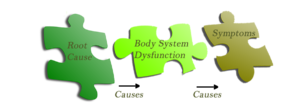
Functional nutrition is really a specialty within the nutrition field. Instead of following the standard one-size-fits-all recommendations on MyPlate, a functional nutritionist will tailor a program for your individual needs. For those people with illness or disease, this involves getting to the root cause of your issue. Modern medical testing looks for end-stage illness, but many of us fly “under the radar” with subtle symptoms until it’s too late. Functional nutrition allows us to dive right to the root causes. And for those who just want to lose weight, get healthier, improve lab numbers, sleep better, have more energy, or any other personal goal, you, too, have individual needs, all the way down to the cellular level!
Food is much more than calories; there are molecules full of information in every single thing you eat, and they can affect every process, behavior and feeling. With functional testing, we can look at biochemical pathways in the body, and determine your individual needs. Then we can create a diet, lifestyle and supplement regimen that will restore and maintain your health, from the cellular level.
What does this approach look like, and what should you expect?
A comprehensive review might look something like this:
• Evaluation of medical history and labs
• Organ system review
• Medication and supplement history
• Diet, exercise and lifestyle habits
• Functional testing to determine nutrient levels, genetic markers and GI health
Then we will move on to customized recommendations, that will include some or all of the following:
• Change in diet
• Education and strategies on managing stress
• Supplements
• Exercise suggestions
• Sleep hygiene suggestions
We will meet 1-2 per month, and depending on progress, we will meet for anywhere from 3 months to a year. Once we get you to a stable point where health is improved, you may not need to see me again, or perhaps we meet for a tune-up once a year!
Contact me now to learn about how functional nutrition can help you meet your goals.
Christine Meraklis
www.christinemeraklis.com
410-991-4534

